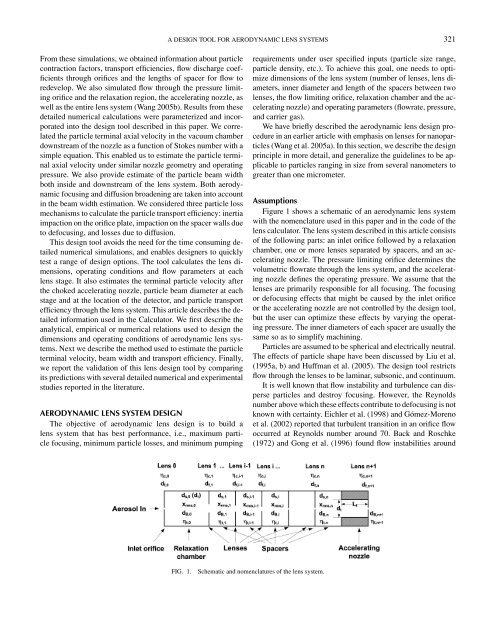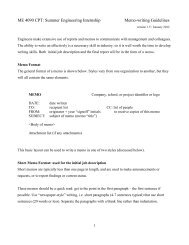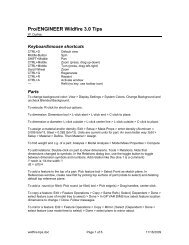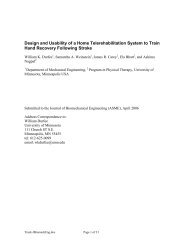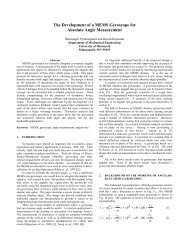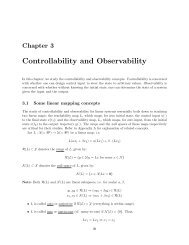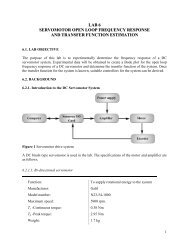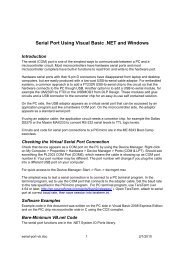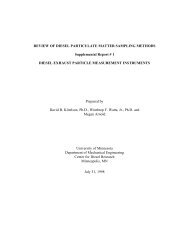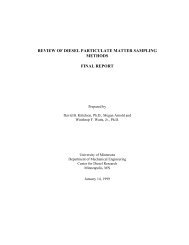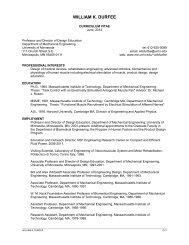A Design Tool for Aerodynamic Lens Systems - Department of ...
A Design Tool for Aerodynamic Lens Systems - Department of ...
A Design Tool for Aerodynamic Lens Systems - Department of ...
You also want an ePaper? Increase the reach of your titles
YUMPU automatically turns print PDFs into web optimized ePapers that Google loves.
From these simulations, we obtained in<strong>for</strong>mation about particle<br />
contraction factors, transport efficiencies, flow discharge coefficients<br />
through orifices and the lengths <strong>of</strong> spacer <strong>for</strong> flow to<br />
redevelop. We also simulated flow through the pressure limiting<br />
orifice and the relaxation region, the accelerating nozzle, as<br />
well as the entire lens system (Wang 2005b). Results from these<br />
detailed numerical calculations were parameterized and incorporated<br />
into the design tool described in this paper. We correlated<br />
the particle terminal axial velocity in the vacuum chamber<br />
downstream <strong>of</strong> the nozzle as a function <strong>of</strong> Stokes number with a<br />
simple equation. This enabled us to estimate the particle terminal<br />
axial velocity under similar nozzle geometry and operating<br />
pressure. We also provide estimate <strong>of</strong> the particle beam width<br />
both inside and downstream <strong>of</strong> the lens system. Both aerodynamic<br />
focusing and diffusion broadening are taken into account<br />
in the beam width estimation. We considered three particle loss<br />
mechanisms to calculate the particle transport efficiency: inertia<br />
impaction on the orifice plate, impaction on the spacer walls due<br />
to defocusing, and losses due to diffusion.<br />
This design tool avoids the need <strong>for</strong> the time consuming detailed<br />
numerical simulations, and enables designers to quickly<br />
test a range <strong>of</strong> design options. The tool calculates the lens dimensions,<br />
operating conditions and flow parameters at each<br />
lens stage. It also estimates the terminal particle velocity after<br />
the choked accelerating nozzle, particle beam diameter at each<br />
stage and at the location <strong>of</strong> the detector, and particle transport<br />
efficiency through the lens system. This article describes the detailed<br />
in<strong>for</strong>mation used in the Calculator. We first describe the<br />
analytical, empirical or numerical relations used to design the<br />
dimensions and operating conditions <strong>of</strong> aerodynamic lens systems.<br />
Next we describe the method used to estimate the particle<br />
terminal velocity, beam width and transport efficiency. Finally,<br />
we report the validation <strong>of</strong> this lens design tool by comparing<br />
its predictions with several detailed numerical and experimental<br />
studies reported in the literature.<br />
AERODYNAMIC LENS SYSTEM DESIGN<br />
The objective <strong>of</strong> aerodynamic lens design is to build a<br />
lens system that has best per<strong>for</strong>mance, i.e., maximum particle<br />
focusing, minimum particle losses, and minimum pumping<br />
A DESIGN TOOL FOR AERODYNAMIC LENS SYSTEMS 321<br />
FIG. 1. Schematic and nomenclatures <strong>of</strong> the lens system.<br />
requirements under user specified inputs (particle size range,<br />
particle density, etc.). To achieve this goal, one needs to optimize<br />
dimensions <strong>of</strong> the lens system (number <strong>of</strong> lenses, lens diameters,<br />
inner diameter and length <strong>of</strong> the spacers between two<br />
lenses, the flow limiting orifice, relaxation chamber and the accelerating<br />
nozzle) and operating parameters (flowrate, pressure,<br />
and carrier gas).<br />
We have briefly described the aerodynamic lens design procedure<br />
in an earlier article with emphasis on lenses <strong>for</strong> nanoparticles<br />
(Wang et al. 2005a). In this section, we describe the design<br />
principle in more detail, and generalize the guidelines to be applicable<br />
to particles ranging in size from several nanometers to<br />
greater than one micrometer.<br />
Assumptions<br />
Figure 1 shows a schematic <strong>of</strong> an aerodynamic lens system<br />
with the nomenclature used in this paper and in the code <strong>of</strong> the<br />
lens calculator. The lens system described in this article consists<br />
<strong>of</strong> the following parts: an inlet orifice followed by a relaxation<br />
chamber, one or more lenses separated by spacers, and an accelerating<br />
nozzle. The pressure limiting orifice determines the<br />
volumetric flowrate through the lens system, and the accelerating<br />
nozzle defines the operating pressure. We assume that the<br />
lenses are primarily responsible <strong>for</strong> all focusing. The focusing<br />
or defocusing effects that might be caused by the inlet orifice<br />
or the accelerating nozzle are not controlled by the design tool,<br />
but the user can optimize these effects by varying the operating<br />
pressure. The inner diameters <strong>of</strong> each spacer are usually the<br />
same so as to simplify machining.<br />
Particles are assumed to be spherical and electrically neutral.<br />
The effects <strong>of</strong> particle shape have been discussed by Liu et al.<br />
(1995a, b) and Huffman et al. (2005). The design tool restricts<br />
flow through the lenses to be laminar, subsonic, and continuum.<br />
It is well known that flow instability and turbulence can disperse<br />
particles and destroy focusing. However, the Reynolds<br />
number above which these effects contribute to defocusing is not<br />
known with certainty. Eichler et al. (1998) and Gómez-Moreno<br />
et al. (2002) reported that turbulent transition in an orifice flow<br />
occurred at Reynolds number around 70. Back and Roschke<br />
(1972) and Gong et al. (1996) found flow instabilities around


